Sadoya Manpei Store
A merchant's house dating back to the middile of the Meiji era was thrown open to the public and turned into "Sado Mingei-kan."
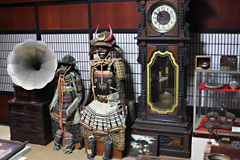 At Sado Mingei-kan, many excellent articles are open to the public which craftsmen have made on Sado Island, where unique culture and performing arts breathe. There are a large number of antique folk crafts unique to Sado, such as Sado funadansu and ishodansu which are also representative of Japanese furniture, Sado tsuba (the plate-like part for the protection of a hand between the haft of a sword and the blade), votive pictures dedicated to shrines and ships, and "Mumyoi-yaki," Sado's pottery which has been made since the Meiji era. What is more, you can also see under your very eyes old works of art such as early Imari ware, rokkoyo pottery (pottery of Shigaraki, Bizen, Tanba, Echizen, Seto and Tokoname), and pottery from China and Korea, which were brought on Kitamaebune (the cargo vessels of the North Country that were actively engaged in transportation in the Sea of Japan from the early modern ages through the Meiji era). These are artcles which can rarely be seen even on Sado Island. (Some of these articles are for sale.)
At Sado Mingei-kan, many excellent articles are open to the public which craftsmen have made on Sado Island, where unique culture and performing arts breathe. There are a large number of antique folk crafts unique to Sado, such as Sado funadansu and ishodansu which are also representative of Japanese furniture, Sado tsuba (the plate-like part for the protection of a hand between the haft of a sword and the blade), votive pictures dedicated to shrines and ships, and "Mumyoi-yaki," Sado's pottery which has been made since the Meiji era. What is more, you can also see under your very eyes old works of art such as early Imari ware, rokkoyo pottery (pottery of Shigaraki, Bizen, Tanba, Echizen, Seto and Tokoname), and pottery from China and Korea, which were brought on Kitamaebune (the cargo vessels of the North Country that were actively engaged in transportation in the Sea of Japan from the early modern ages through the Meiji era). These are artcles which can rarely be seen even on Sado Island. (Some of these articles are for sale.)
"Shio-kobo (Salt Workshop) Sado Kazashiogama," salt made by hand from Sado's sea water
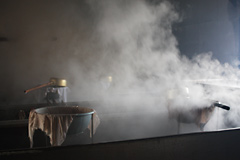 Salt has been produced from ancient times at various parts of Sado Island, which is surrounded by the sea. The study of the relics related to salt shows that most of them concentrate on the west coast of ex-Aikawamachi, and that the production of salt has flourished in the area around Meotoiwa Rocks where "Shiokobo Kazashiogama" is located. Salt-making at this workshop is the revivial of the traditional way of producing salt in which sea water is boiled for a long time by burning firewood and then the grains of salt that have been produced are gathered.
Salt has been produced from ancient times at various parts of Sado Island, which is surrounded by the sea. The study of the relics related to salt shows that most of them concentrate on the west coast of ex-Aikawamachi, and that the production of salt has flourished in the area around Meotoiwa Rocks where "Shiokobo Kazashiogama" is located. Salt-making at this workshop is the revivial of the traditional way of producing salt in which sea water is boiled for a long time by burning firewood and then the grains of salt that have been produced are gathered.
The hyososui around Meotoiwa Rocks (sea water rich in natural minerals where turban shells, wakame seaweed and small fish live) is used as raw material, and the finished product is the salt which has a rich, mellow and slightly sweet flavor.
Sadodansu which Sado's craftsmen made ("Dansu," or "tansu," means a chest of drawers.)
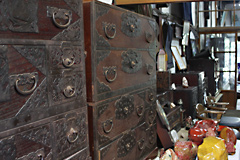 【Funadansu】
【Funadansu】
The funadance is a chest of drawers used on board Kitamaebune. It was made smaller so that it would be easier to carry around. To make it hard to break in case the ship was wrecked, the outside of the chest was protected by hard zelkova and armor-like steel fittings. It was of complex and elaborate make, with secret boxes hidden inside.
【Ogidansu】
It is said that the ogidansu stems from a wardrobe which funadansu craftsmen made for geisha girls at the request of the skippers of Kitamaebune. Many of them are of gorgeous make, employing the funadansu craftsmen's excellent skills in woodwork and metalwork. It is also called a "geisha-dansu."
【Yahatadansu】
The origin of the yahatadansu is said to be a "container" which was made at the request of the Magistrate of Sado in the middle of the Edo era. Compared with an ogidansu, the metal fittings of yahatadansu are a little thin, but the proportion of the fittings to the whole of the tansu is large, and it is flashy and has openwork of auspicious designs that make the most of the beauty of straight lines.
More details
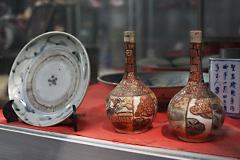
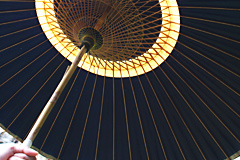
| name of facility | Sadoya Manpei Store |
|---|---|
| address | 286 Mano-shinmachi, Sado City, Niigata Prefecture |
| website | http://www4.ocn.ne.jp/~s-mingei/ (Japanese only) |
| business hours | 8:00 - 19:00 |
| a regular holiday | The 1st of every month |
| a parking place, a parking lot |
The parking place is at the back of the store. The parking of up to three cars is possible. ※The public parking places of the Mano district are also available. |
| a charge for using (…) |
Sado Mingei-kan (Sado Folk Crafts Museum) Admission fee (tax included) Adults / 300 yen Children / 100 yen Explanations of the articles are given. Green tea is served, too. |
| payment method | cash |